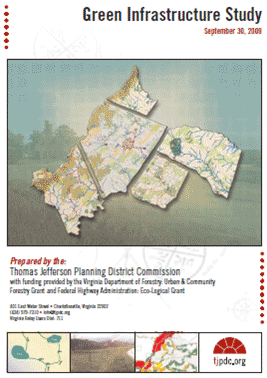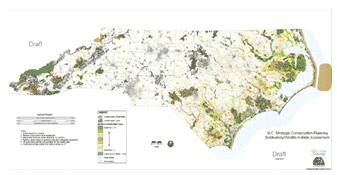|
The Federal Highway Administration (FHWA) established the Eco-Logical grant program in 2007 to pilot a new, more ecosystem-sensitive approach to infrastructure development. Currently, the program is funding 15 projects across the country. The program is aimed at applying the goals and principles outlined in the 2006 multiagency publication Eco-Logical: An Eco-System Approach to Developing Infrastructure Projects. This issue of Successes in Stewardship highlights three projects funded by the Eco-Logical grant program that demonstrate the strength of Eco-Logical in action.
The Eco-Logical approach encourages all partners and stakeholders involved in infrastructure planning, design, environmental review, and construction to utilize the flexibility in regulatory processes. This flexibility can help partners and stakeholders to conduct their work on an ecosystem scale not defined by political boundaries. Specifically, Eco-Logical puts forth a conceptual framework for integrating transportation, conservation, and other types of plans across agency and disciplinary boundaries and endorses ecosystem-based mitigation for infrastructure impacts.
FHWA has been actively carrying out the Eco-Logical grant program through the continuously tracking of all 15 grant projects and by monitoring associated successes and challenges. The Thomas Jefferson Planning District Commission, the U.S. Environmental Protection Agency Region 6, and the North Carolina Department of Environment and Natural Resources are three excellent examples of success. All of the Eco-Logical grant projects have made progress in implementing the Eco-Logical approach. These three projects are particularly illustrative of Eco-Logical principles working effectively in practice.

The cover of the TJPDC Green Infrastructure Study. Graphic courtesy of TJPDC.
Thomas Jefferson Planning District Commission, Virginia
The goal of the Thomas Jefferson Planning District Commission (TJPDC) Eco-Logical project is to develop a green infrastructure plan connecting transportation, development, and natural resource plans within the planning district. TJPDCis the metropolitan planning organization (MPO) for a five-county planning district centered around the city of Charlottesville, Virginia. For a long time, the TJPDC environmental program has focused on regional-scale environmental issues, including sustainability, water resources, and solid waste. In 2008, the environmental program staff was awarded an Eco-Logical grant to continue work that had begun with a U.S. Forest Service grant. The Eco-Logical grant has been pivotal to TJPDC achieving its goal.
Over the past year, the project team has made great strides, completing a green infrastructure study and gaining support for the study from all five TJPDC member governments. TJPDC defines green infrastructure as an interconnected network of green spaces that conserves natural ecosystem values and functions and that provides benefits to human populations. This network is made up of large habitat areas linked by greenway corridors. The study also connects existing regional plans to identify locations for economic development and conservation. TJPDC has incorporated the environmental analysis portion of the study into its recently adopted long-range transportation plan (LRTP). The Eco-Logical project has allowed TJPDC to bring diverse stakeholders together to seek shared priorities. The project team believes that these conversations will lead to the creation of a collaborative forum for transportation and environmental agencies.
In the next stages of the project, the project team will overlay planned transportation projects on the green infrastructure data to connect transportation and environmental information. This will allow TJPDC to identify potential impact and mitigation areas. Once these overlays are complete, TJPDC will hold meetings with local governments, regulatory agencies, and public groups to present the findings of the overlay and discuss the identified impacts and mitigation opportunities. TJPDC hopes to achieve consensus on mitigation priorities by working with all of the groups involved in the meetings to focus on overall priorities and adopt a broader perspective of mitigation and development in the region.
U.S. Environmental Protection Agency, Region 6
The goal of the U.S. Environmental Protection Agency (EPA) Region 6 Eco-Logical project is to create an expansion of the Texas Ecological Assessment Protocol (TEAP). This expansion will be known as the Regional Ecological Assessment Protocol (REAP) and will cover all five States in EPARegion 6 (Arkansas, Louisiana, New Mexico, Oklahoma, and Texas) as well as 66 tribes. TEAPand REAPare planning and screening assessment tools that use existing geographic information system (GIS) data to classify land on the basis of ecological importance. This Eco-Logical grant project is compatible with EPA Region 6's stated vision "to meet the environmental needs of a changing world" and is an important resource for EPA Region 6.
Through the Eco-Logical grant-program process, the EPA project team has developed new relationships with its stakeholders and found new opportunities for environmental agencies to employ GISmodeling. The project team had not established relationships with all of the applicable State-level agencies in the region prior to this Eco-Logical grant project. Initially, some agencies were reluctant to share specific data. By working with each group to explain that data would be shown only as part of a composite and that no sensitive information would be exposed, the team was eventually able to enlist agencies to provide the data that it needed to complete the REAP.
EPA Region 6 has made significant progress in accomplishing its goal and at the same time has spurred direct benefits for transportation planners, EPA staff, and FHWA Division Offices. Two major benefits are that REAP will allow transportation planners to identify areas of avoidance and to determine the environmental impacts of different transportation alternatives. REAP is unique in that it can interface with other EPA GIS tools by entering outputs into other EPA tools and enhancing available information for planners and National Environmental Policy Act (NEPA) reviewers. Potential uses for REAP and its associated tools include:
- Supporting the LRTPprocess.
- Supporting shorter-term planning for complex projects and mitigation.
- Conducting NEPAanalysis during the scoping phase.
- Meeting consultation requirements of the Safe, Accountable, Flexible, Efficient, Transportation Act: A Legacy for Users (SAFETEA-LU).
When REAP is complete, EPA staff will visit State Departments of Transportation and FHWA Division Offices to provide information and training on the tool. EPA Region 6 staff hopes not only to expand its planning and screening assessment tools but also to open dialogue about joint planning between transportation and wildlife agencies.

An image from the Conservation Planning Tool. Graphic courtesy of NCDENR.
North Carolina Department of Environment and Natural Resources
The goal of the North Carolina Department of Environmental and Natural Resources (NCDENR) Eco-Logical grant project is to develop a Conservation Planning Tool for the State. NCDENRis collaborating with the North Carolina Department of Transportation (NCDOT) to integrate the Eco-Logical framework into the transportation-planning process. NCDENR is the lead stewardship agency in North Carolina (NC), charged with preservation and protection of NC's natural resources. The Conservation Planning Tool is a new data system that, along with other outreach and coordination components of the project, will allow NCDENR to work with its project partners to ensure that all transportation and resource data that NCDENR collects remain current and are actively applied to transportation-planning projects. The data currently in the system received validation from the Natural Heritage Trust Fund Board of Trustees as well as other NC land trusts that are already using the data in their day-to-day practices or are requiring their partners to do so.
NCDENR meets regularly with an Interagency Leadership Team comprising Federal and State resource and transportation agencies. These agencies collaborate to determine how to make mapping and data most useful in the transportation-planning and delivery processes.
NCDENR completed a pilot in the city of Hickory in order to test the Conservation Planning Tool and other associated data. NCDENR provided the Hickory MPOwith the tool and its associated data to see where they could be useful in the transportation-planning process. The Hickory MPO found the tool and, specifically, its biodiversity data layer, to be helpful in preplanning and setting fieldwork priorities.
As NCDENR builds a biodiversity layer for the rest of the State, it will circulate these data to all of NC's regional planning organizations and MPOs for use in preplanning. NCDENR believes that the new data will help transportation planners to avoid environmentally sensitive areas when planning projects.
NCDENR will continue to integrate ecological considerations into planning processes that are traditionally motivated by economic and transportation priorities. NCDENR hopes that providing strong and reliable data showing clear benefits of the Eco-Logical approach will help transportation agencies to focus on the importance of ecological values in the planning of priorities. To directly impact the transportation-planning process, NCDENR staff is serving on an interagency integration team (separate from the Interagency Leadership Team) at NCDOTto improve the long-range planning process.
Trends and Findings
FHWA staff has been documenting results that have emerged in the quarterly and annual grant reports completed by grant recipients and FHWA. These findings demonstrate the strengths of Eco-Logical and the positive outcomes of investing in collaborative decisionmaking and ecosystem-sensitive planning processes. The findings include:
- Grant recipients developed new and stronger partnerships with Federal, State, and local resource and transportation agencies as well as nongovernmental organizations. Most Eco-Logical grant recipients are meeting project milestones on or ahead of schedule.
- The majority of Eco-Logical grant recipients will organizationally adopt some or all of the principles of the Eco-Logical approach after their grant projects are complete.
- Grant recipients plan to incorporate Eco-Logical principles and outcomes from their projects into local, State, and regional plans.
These trends demonstrate the applicability of Eco-Logical to a range of planning scales and the importance of pilot programs such as the FHWA Eco-Logical grant program. To learn more about the program, visit the FHWA Eco-Logical website.
|

